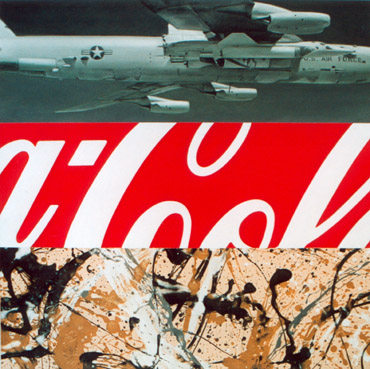 |
|||
|
Pop Art Style Painting No. 3 (Capitalist Realism) (2002) Oil on canvas, 80x80cm Private collection Unlike the first two Pop Art Style Paintings, No.3 was constructed in a rather more considered manner. 'Capitalist realism' was the term Gerhard Richter and Konrad Lueg came up for an exhibition in 1963, and subsequently came to define a mode of European painting that was influenced by American Pop Art. The term echoes the state art of the Soviet Union, socialist realism, (Richter was from East Germany and had trained in the style of socialist realism). The three elements in the present picture explain how the US influenced the post-war world: the B52 bomber, which carried nuclear weapons, representing the US military, Coca-Cola, a universally recognised symbol, epitomises popular culture, and high culture is represented by a detail of Jackson Pollock's Autumn Rhythm Number 30, 1950 (the US government actively promoted Abstract Expressionism abroad as a weapon in the Cold War). There is something ironic in reproducing an abstract expressionist painting in a careful, considered trompe l'oeil manner, though of course I wasn't the first to this: Glenn Brown's The Day The World Turned Auerbach knocks my Pollock detail into a cocked hat. Someone recently asked me whether I considered that I painted or copied. I said I copied, though Richter can better explain the implications: Do you know what was great? Finding out that a stupid, ridiculous thing like copying a postcard could lead to a picture. And then the freedom to paint whatever you felt like. Stags, aircraft, kings, secretaries. Not having to invent anything anymore, forgetting everything you meant by painting- colour, composition, space- and all the things you previously knew and thought. Suddenly none of this was a prior necessity for art. Gerhard Richter, The Daily Practice of Painting: Writings 1960-1993 ©copyright 2018 Nicholas Middleton |
|||